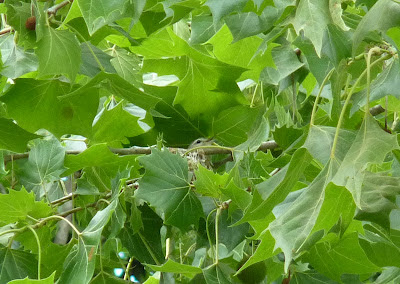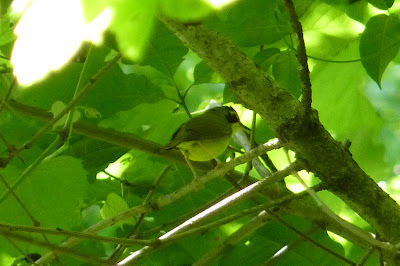Emails were flying around over the long weekend about a pair of Warbler Vireos nesting in Raleigh. I really wanted to see these birds, but was stuck up in New England (looking at different Warbling Vireos, among other birds). So as soon as I got home and had the chance, I zipped out to Shelley Lake Park to see them for myself.
Why are these birds so special? Well, just take a look a Cornell's breeding range map for the species...
Central North Carolina is just about the only spot in the country that these birds should not be breeding. Yet here one is nesting in Wake County....
And this is a species that is tricky to find anywhere in NC (state bird #313 for me!).
I've heard birders say that song birds don't sing when they're sitting on eggs.
Well it wasn't true with this pair at least. I saw the female fly off the nest and then off to forage and the male take her place and continue singing away while incubating the eggs (a rare male multi-tasker!). And when he wasn't on the nest he was very busy chasing away grackles.
It will be interesting to see how this pair does so far out of their expect range and in a spot with such a high density of nest predators (i.e. grackles, crows, Blue Jays). The odds-makers on the carolinabirds listeserve don't seem to have much confidence!
Congratulation to Lynn Erla Beagle and her group from Wake Audubon for finding this unusual pair. And thanks to Mike Turner for posting detailed instructions and GPS coordinates that many folks (including me) used to easily locate the nest.
Why are these birds so special? Well, just take a look a Cornell's breeding range map for the species...
 |
| (map by Cornell Lab of Ornithology) |
Central North Carolina is just about the only spot in the country that these birds should not be breeding. Yet here one is nesting in Wake County....
 |
| Female Warbling Vireo nesting in Raleigh |
I've heard birders say that song birds don't sing when they're sitting on eggs.
 |
| Male Warbling Vireo singing while incubating |
Well it wasn't true with this pair at least. I saw the female fly off the nest and then off to forage and the male take her place and continue singing away while incubating the eggs (a rare male multi-tasker!). And when he wasn't on the nest he was very busy chasing away grackles.
It will be interesting to see how this pair does so far out of their expect range and in a spot with such a high density of nest predators (i.e. grackles, crows, Blue Jays). The odds-makers on the carolinabirds listeserve don't seem to have much confidence!
Congratulation to Lynn Erla Beagle and her group from Wake Audubon for finding this unusual pair. And thanks to Mike Turner for posting detailed instructions and GPS coordinates that many folks (including me) used to easily locate the nest.


















